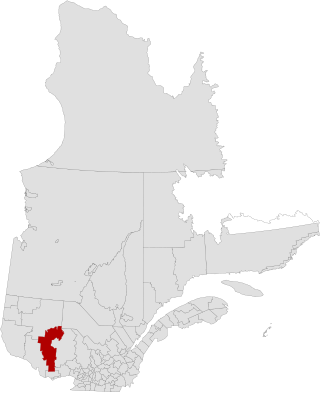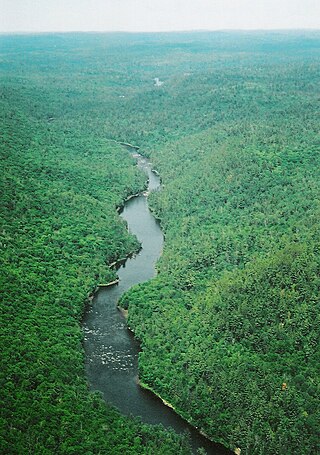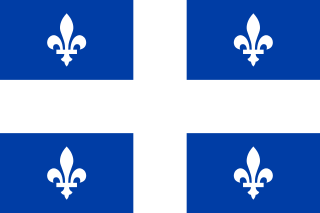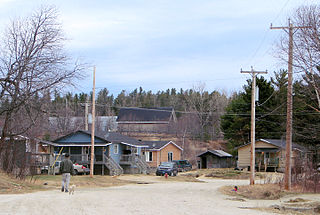
The Ottawa River is a river in the Canadian provinces of Ontario and Quebec. It is named after the Algonquin word 'to trade', as it was the major trade route of Eastern Canada at the time. For most of its length, it defines the border between these two provinces. It is a major tributary of the St. Lawrence River and the longest river in Quebec.

The Algonquin people are an Indigenous people who now live in Eastern Canada. They speak the Algonquin language, which is part of the Algonquian language family. Culturally and linguistically, they are closely related to the Odawa, Potawatomi, Ojibwe, Mississaugas, and Nipissing, with whom they form the larger Anicinàpe (Anishinaabeg). Algonquins are known by many names, including Omàmiwinini and Abitibiwinni or the more generalised name of Anicinàpe.

La Vallée-de-la-Gatineau is a regional county municipality in the Outaouais region of western Quebec, Canada. The seat is in Gracefield. It was incorporated on January 1, 1983 and was named for its location straddling the Gatineau River north of Low.
Indigenous peoples in Quebec total eleven distinct ethnic groups. The one Inuit community and ten First Nations communities number 141,915 people and account for approximately two per cent of the population of Quebec, Canada.

Kanesatake is a Mohawk settlement on the shore of the Lake of Two Mountains in southwestern Quebec, Canada, at the confluence of the Ottawa and Saint Lawrence rivers and about 48 kilometres (30 mi) west of Montreal. People who reside in Kanehsatà:ke are referred to as Mohawks of Kanesatake. As of 2022, the total registered population was 2,751, with a total of about 1,364 persons living on the territory. Both they and the Mohawk of Kahnawake, Quebec, a reserve located south of the river from Montreal, also control and have hunting and fishing rights to Doncaster 17 Indian Reserve.

La Vérendrye wildlife reserve is one of the largest reserves in the province of Quebec, Canada, covering 12,589 square kilometres (4,861 sq mi) of contiguous land and lake area. It is named after Pierre Gaultier de Varennes, sieur de La Vérendrye, a French-Canadian explorer. Located 180 kilometres (110 mi) north of Ottawa, it is traversed from south to north by Route 117.

Oka is a small village on the northern bank of the Ottawa River, northwest of Montreal, Quebec, Canada. Located in the Laurentians valley on Lake of Two Mountains, where the Ottawa has its confluence with the St. Lawrence River, the town is connected via Quebec Route 344. It is located 50 km west of Montreal.

The Dumoine River is a river in western Quebec with its source in Machin Lake near La Vérendrye Wildlife Reserve. From Dumoine Lake, the river flows almost due south off the Canadian Shield and empties into the Ottawa River, just west of Rapides-des-Joachims, Quebec, or Rolphton, Ontario. The river is 129 kilometres (80 mi) long and drains a watershed of 5,380 square kilometres (2,080 sq mi). This relatively short river compared to its drainage area indicates that the Dumoine has a strong current and many steep-gradient rapids.
The Ojibwe language is spoken in a series of dialects occupying adjacent territories, forming a language complex in which mutual intelligibility between adjacent dialects may be comparatively high but declines between some non-adjacent dialects. Mutual intelligibility between some non-adjacent dialects, notably Ottawa, Severn Ojibwe, and Algonquin, is low enough that they could be considered distinct languages. There is no single dialect that is considered the most prestigious or most prominent, and no standard writing system that covers all dialects. The relative autonomy of the regional dialects of Ojibwe is associated with an absence of linguistic or political unity among Ojibwe-speaking groups.

The Gens de Terre River is a river in central Quebec, Canada. It is located on the eastern edge of the La Vérendrye Wildlife Reserve in the La Vallée-de-la-Gatineau Regional County Municipality in the Outaouais region. Its source is the Cabonga Reservoir from where it flows in a mostly southern direction for 115 km and drains into the Gens de Terre Bay of the Baskatong Reservoir.

Lac-Pythonga is an unorganized territory in the Outaouais region of Quebec, Canada. It surrounds Lake Pythonga and is the largest of the five unorganized territories in the La Vallée-de-la-Gatineau Regional County Municipality.

Kitigan Zibi is a First Nations reserve of the Kitigan Zibi Anishinabeg First Nation, an Algonquin band. It is situated near the confluence of the Désert and Gatineau Rivers, and borders south-west on the Town of Maniwaki in the Outaouais region of Quebec, Canada. Having a total area of 210.09 km2 (81.12 sq mi), it is the largest Algonquin Nation in Canada in both area and population.

The Cabonga Reservoir is a man-made lake in central Quebec, Canada, with a total surface area of 677 square kilometres (261 sq mi) and a net area of 484 square kilometres (187 sq mi). It is located on the boundary between the unorganized territories of Lac-Pythonga and Réservoir-Dozois, and fully within the La Vérendrye Wildlife Reserve. The First Nations reserve of Rapide Lake is on its western shores.

The Dozois Reservoir is a man-made lake in central Quebec, Canada. It is fully within the unorganized territory of Réservoir-Dozois and the La Vérendrye Wildlife Reserve.
Coucoucache was a tiny First Nation reserve, in Cloutier Township, on the north shore of Reservoir Blanc on the Saint-Maurice River in the Mauricie region of Quebec, Canada. It belonged to the Atikamekw First Nation of Wemotaci but had no permanent population in recent decades.

The following outline is provided as an overview of and topical guide to Quebec:
The ZEC Bras-Coupé-Desert is a "zone d'exploitation contrôlée" (ZEC), located in the unorganized territory of Lac-Pythonga in La Vallée-de-la-Gatineau Regional County Municipality, in the administrative region of Outaouais, in Quebec, in Canada.

Algonquins of Barriere Lake are an Algonquin First Nation in Quebec, Canada. They primarily live on the Indian reserve of Rapid Lake in Outaouais. In 2017 the band had a registered population of 792 members. It is part of Algonquin Nation Programs and Services Secretariat.
The Kitcisakik Anicinape Community, which the official name is communauté anicinape de Kitcisakik, is an Indian band of the Algonquin First Nations in Quebec, Canada. The majority of its members lives on the Indian settlement of Kitcisakik, also called Grand-Lac Victoria, located on the shore of the Grand lac Victoria on La Vérendrye Wildlife Reserve, where is also located the band council, the Conseil des Anicinapek de Kitcisakik. In 2017 the band had a registered population of 498 members.
The Barriere Lake Trilateral Agreement is a resource co-management framework covering 1 million hectares of traditional Algonquin territory in Northern Quebec. It was signed August 22, 1991 by the Algonquins of Barriere Lake, The Government of Quebec, and the Government of Canada. The agreement set out four years to conduct a comprehensive evaluation of the forestry and wildlife resources in the region and draft and implement a long-term integrated co-management plan between the Algonquin community and the Government of Quebec. It is considered significant in that it presented a model example of indigenous co-management and an alternative to comprehensive land claims policies based on extinguishing title. It was commended by the United Nations as a trailblazer of indigenous-state partnership and sustainable development. The principles of the Trilateral agreement have been upheld as a promising example of indigenous sovereignty and reconciliation for other projects across Canada
















